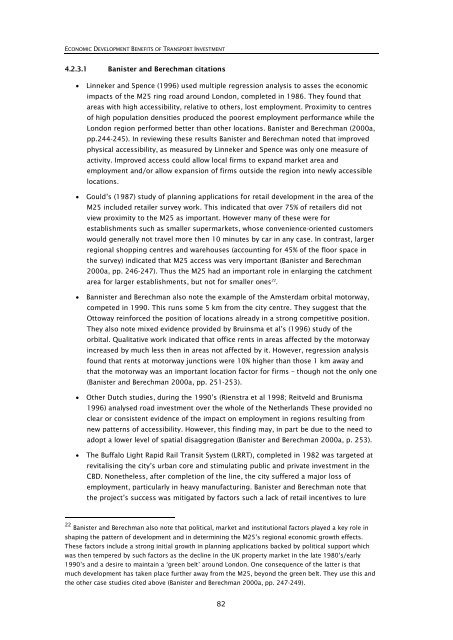Research 350 - NZ Transport Agency
Research 350 - NZ Transport Agency
Research 350 - NZ Transport Agency
Create successful ePaper yourself
Turn your PDF publications into a flip-book with our unique Google optimized e-Paper software.
ECONOMIC DEVELOPMENT BENEFITS OF TRANSPORT INVESTMENT<br />
4.2.3.1 Banister and Berechman citations<br />
• Linneker and Spence (1996) used multiple regression analysis to asses the economic<br />
impacts of the M25 ring road around London, completed in 1986. They found that<br />
areas with high accessibility, relative to others, lost employment. Proximity to centres<br />
of high population densities produced the poorest employment performance while the<br />
London region performed better than other locations. Banister and Berechman (2000a,<br />
pp.244-245). In reviewing these results Banister and Berechman noted that improved<br />
physical accessibility, as measured by Linneker and Spence was only one measure of<br />
activity. Improved access could allow local firms to expand market area and<br />
employment and/or allow expansion of firms outside the region into newly accessible<br />
locations.<br />
• Gould’s (1987) study of planning applications for retail development in the area of the<br />
M25 included retailer survey work. This indicated that over 75% of retailers did not<br />
view proximity to the M25 as important. However many of these were for<br />
establishments such as smaller supermarkets, whose convenience-oriented customers<br />
would generally not travel more then 10 minutes by car in any case. In contrast, larger<br />
regional shopping centres and warehouses (accounting for 45% of the floor space in<br />
the survey) indicated that M25 access was very important (Banister and Berechman<br />
2000a, pp. 246-247). Thus the M25 had an important role in enlarging the catchment<br />
area for larger establishments, but not for smaller ones 22 .<br />
• Bannister and Berechman also note the example of the Amsterdam orbital motorway,<br />
competed in 1990. This runs some 5 km from the city centre. They suggest that the<br />
Ottoway reinforced the position of locations already in a strong competitive position.<br />
They also note mixed evidence provided by Bruinsma et al’s (1996) study of the<br />
orbital. Qualitative work indicated that office rents in areas affected by the motorway<br />
increased by much less then in areas not affected by it. However, regression analysis<br />
found that rents at motorway junctions were 10% higher than those 1 km away and<br />
that the motorway was an important location factor for firms – though not the only one<br />
(Banister and Berechman 2000a, pp. 251-253).<br />
• Other Dutch studies, during the 1990’s (Rienstra et al 1998; Reitveld and Brunisma<br />
1996) analysed road investment over the whole of the Netherlands These provided no<br />
clear or consistent evidence of the impact on employment in regions resulting from<br />
new patterns of accessibility. However, this finding may, in part be due to the need to<br />
adopt a lower level of spatial disaggregation (Banister and Berechman 2000a, p. 253).<br />
• The Buffalo Light Rapid Rail Transit System (LRRT), completed in 1982 was targeted at<br />
revitalising the city’s urban core and stimulating public and private investment in the<br />
CBD. Nonetheless, after completion of the line, the city suffered a major loss of<br />
employment, particularly in heavy manufacturing. Banister and Berechman note that<br />
the project’s success was mitigated by factors such a lack of retail incentives to lure<br />
22 Banister and Berechman also note that political, market and institutional factors played a key role in<br />
shaping the pattern of development and in determining the M25’s regional economic growth effects.<br />
These factors include a strong initial growth in planning applications backed by political support which<br />
was then tempered by such factors as the decline in the UK property market in the late 1980’s/early<br />
1990’s and a desire to maintain a ‘green belt’ around London. One consequence of the latter is that<br />
much development has taken place further away from the M25, beyond the green belt. They use this and<br />
the other case studies cited above (Banister and Berechman 2000a, pp. 247-249).<br />
82
















